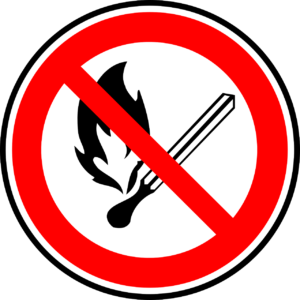What Needs To Be Included In A Fire Safety Risk Assessment

There are a lot of processes and documents to complete in any business, and a fire risk assessment is one of the most important when it comes to Health and Safety for the workplace and the people working there.
All employers have a duty of care to their employees to provide a safe working environment, which is why there is so much documentation around any aspect of Health and Safety. It proves that great care was taken to fulfil these obligations to the best of their ability, while limiting liability should an incident occur.
While it is difficult to account for every possible outcome, being able to point to any steps taken to mitigate risks and hazards, as well as updates to documents to show initiative when something new is brought to light, goes a long way in instilling confidence in the company’s policies and processes. The same is true for fire risk assessments.
What Is A Fire Risk Assessment?
A fire risk assessment is similar to other risk assessments in that the point is to highlight potential risks and hazards to the workplace and staff as well as putting measures in place to reduce the likelihood of an accident occurring. In this instance, these risks and hazards relate directly to fires, the processes around them and anything that could cause or harm people in the business as they evacuate.
While the process for identifying hazards and risks will be similar, and the documents themselves can start with the same template, the things that need to be looked at and considered will differ. This means you cannot rely on a generic risk assessment to cover all of what’s needed on a fire safety risk assessment – but you might be able to use some of the hazards already identified elsewhere.
Who Is Responsible For Completing A Fire Risk Assessment?

When it comes to carrying out a fire safety risk assessment, there’s no specific requirements for the person that must complete it, but someone must be assigned to do so. Legal guidelines state that it must be a “competent individual”, which means someone who is comfortable with assessing the building premises and identifying all the potential risks.
As part of the fire safety risk assessment, this individual must be able to record all their findings in clear detail, develop a fire safety action plan for any changes needed and implement those changes as soon as possible. The individual must then update the risk assessment regularly so it’s always up-to-date and relevant.
A qualified Fire Risk Assessor can ensure all of this happens and is done to the right standards for your business. They undergo rigorous training on the most recent requirements and guidelines, which is why they can often be a good choice for any organisation.
How Often Should Fire Risk Assessments Be Reviewed?

Once the fire risk assessment has been completed, it should be reviewed at least once every twelve months to ensure it remains accurate and comprehensive. If new risks are identified, a full review is recommended.
A new risk assessment should be completed every five years to ensure nothing is missed and that it remains as relevant and useful as possible. After this much time, a new document ensures former risks that are no longer relevant don’t take up space or hide more important issues. It also means that everything is looked at in depth on a regular basis.
Other reasons you should complete a review of a fire safety risk assessment is if the building has undergone substantial alterations, such as a new layout or extension, if the purpose of the building has been changed or nature of the occupants is different from the last review.
Why Are Fire Risk Assessments Important?

The most obvious reason why fire safety risks assessments are so important is because they can save lives. While business owners should, and do, take all steps possible to reduce the risk of accident and injury, sometimes a situation arises that was unexpected or against the odds. Without a risk assessment to determine what needs to be addressed, and plans to help everyone in such events, injury or even death could occur.
It is also a legal requirement to have a fire risk assessment, and there are potentially very serious consequences if businesses should choose to ignore completing this part of their Health and Safety process.
What Should Be On A Fire Safety Risk Assessment Checklist?
Every business and property is different, and that means the hazards and risks to check for will vary. There are some common issues to identify for any fire safety risk assessment checklist, as well as specific industry or location problems that need to be addressed.
On your fire safety risk assessment, consider:
- The building’s construction, layout, and use
- The nature and number of occupants, including any potentially vulnerable occupants
- Smoking areas as well as prevention measures that have been taken to prevent fires caused by smoking
- Electrical equipment on the site that could be a potential source of ignition
- Whether the building has a history of any fire loss
- Protection against fires that are caused by lighting
- Installed and portable heating devices that can trigger fires
- Any fire hazards that have been introduced by outside contractors or building works
- Defense against arson
- General housekeeping and key areas being kept clear of any combustible materials
- Whether or not there is evacuation drills and fire safety training on a regular basis
- The configuration and maintenance of escape routes
- The appropriate fire extinguishers are in the correct locations
- Adequate means are in place to raise the alarm in the event of a fire
- Storage arrangements for any flammable and dangerous liquids
- Emergency lighting has been properly installed and is in good working order
- Other devices, like sprinklers, are properly installed and maintained
- Fire safety signs are in the proper locations and used correctly
- Who manages the building’s fire safety and how well it is done
- Proper records and documentation are being kept on fire safety measures
- Measures are in placed for limiting fire spread
- Correct testing procedures and maintenance are in place for fire safety systems.
This list isn’t exhaustive, and there may be other hazards you need to include and address, but it is a good place to start.
What Happens If There Is No Fire Risk Assessment?
If a business does not complete a fire safety risk assessment and keep records of it, then there are potentially severe consequences to face. This is just one of many Health and Safety documents required by law to ensure a workplace is safe and that the wellbeing of staff, customers and visitors to the premises are kept safe.
Failure to complete one of these assessments results in prosecution. This would certainly see a very large fine being handed down to the business and its owner, while there is also the possibility of prison sentences if extreme negligence can be proven. There is no better scenario than simply completing the fire safety risk assessment as soon as possible.
Want To Know More About Fire Safety Risk Assessments?
Fire risk assessments should not be taken lightly. Not only can fires cause injury or death to staff and anyone else visiting the business, such as customers, clients or visitors, but the damage to the property can also cause disruption to the business and bring financial problems that cause more issues down the line.
If you’d like to know more fire safety risk assessments, or you need help to make sure this part of your Health and Safety file is completed correctly and accurately, contact our team of experts at Rhino Safety.
